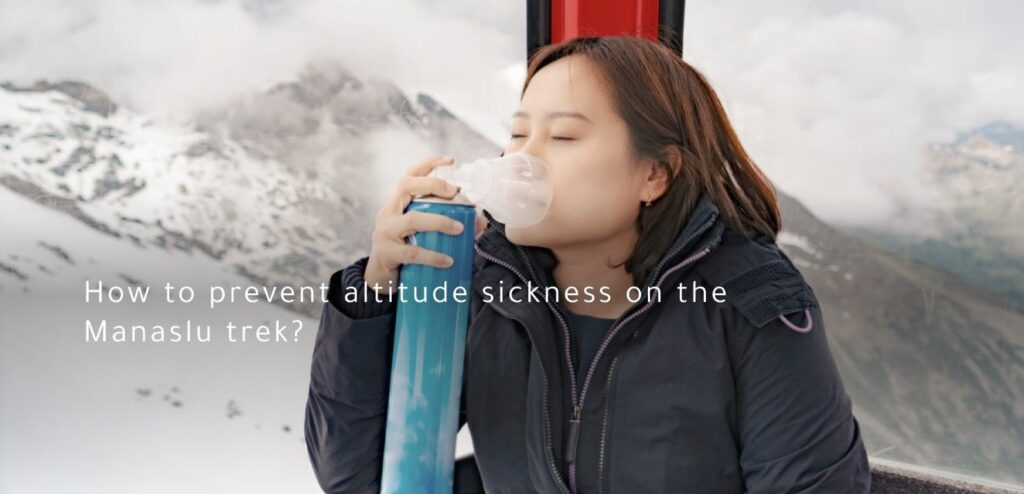Introduction:
If you are wondering how to prevent altitude sickness on the Manaslu trek, then you’re at the right place! Manaslu Circuit Trek is a top-notch trek situated approximately 50 miles away from the capital city of Kathmandu. Discovering the concealed magnificence of Manaslu Valley and conquering Larkya La Pass during this trek will surpass your wildest dreams. Trekking in Manaslu, the eighth-highest mountain in the world at 8,163 meters, is an exhilarating and equally demanding endeavor. It demands a great deal of adventurous spirit, training, planning, and preparation.
Manaslu Circuit and other well-known treks are full of adventure and equally challenging. Numerous trekkers, particularly beginners, contemplate how they can cope with the increased elevation. The Manaslu Circuit Trek begins in Soti Khola, which is located at an altitude of 700 meters. Each day, you will ascend to higher altitudes until reaching the summit. Altitude sickness is a major concern and a common issue that many trekkers encounter during such treks. It is essential for every trekker to be aware of altitude sickness when trekking in high-altitude regions and how to prevent altitude sickness.
What is Altitude Sickness?:
As you ascend to higher altitudes, the air pressure decreases and the oxygen levels in the air decrease as well. While it is possible for people to live in moderately high areas, the body requires time to acclimate to the changes. However, if you surpass an altitude of 8,000 feet, you may begin to experience discomfort or potentially encounter hazardous situations due to the sudden change in altitude.
Types of Altitude Sickness:
- Acute Mountain Sickness (AMS):
When you ascend to high altitudes, you may experience illness, but it is generally not severe. This illness is known as acute mountain sickness. Individuals who climb tall mountains or engage in activities like skiing in high locations such as Colorado may be susceptible to it. If you begin to feel unwell, descending to a lower altitude can greatly alleviate the symptoms. Even taking a short break before ascending further can help alleviate the sickness if it is not too severe. Typically, this type of sickness manifests between 8 to 36 hours after ascending.
Symptoms of Acute Mountain Sickness (AMS):
- Headache
- Weakness or fatigue
- Dizziness or lightheadedness
- Nausea or vomiting
- Difficulty sleeping
- Loss of appetite
- High Altitude Pulmonary Edema (HAPE):
High Altitude Pulmonary Edema (HAPE) is a severe illness that occurs at high altitudes and is more serious than regular altitude sickness. It is characterized by excessive fluid accumulation in the lungs, resulting in difficulty breathing. HAPE is a life-threatening condition that can occur when ascending to high altitudes too rapidly. Rapid ascent, strenuous physical activity, and disregarding mild symptoms can increase the risk of developing HAPE.
Symptoms of High Altitude Pulmonary Edema (HAPE):
- Headache(gets worsening) and vomiting
- Walking with a staggering gait
- Changes in normal behavior
- Changes in the ability to think
- Confusion and Exhaustion
- Hallucinations (seeing things that are not real)
- Coma (in advanced cases)
- High Altitude Cerebral Edema (HACE):
High Altitude Cerebral Edema (HACE) is an extremely severe and uncommon form of altitude sickness that occurs in individuals who ascend to very high altitudes, typically above 6000 meters. Failure to address the initial symptoms of altitude sickness or the more severe forms such as HAPE, and continuing to ascend, can result in the development of HACE. This condition occurs when the brain swells due to the physiological changes that occur at high altitudes. If immediate medical attention is not sought and the affected individual does not descend to lower elevations, it can lead to a coma and, in some cases, even death.
Symptoms of High Altitude Cerebral Edema (HACE):
- Chest tightness
- Extreme fatigue and inability to catch your breath, even when resting
- Coughing, which may produce pink frothy fluid
- Blue or gray lips and fingernails
- Noises when breathing, such as rattling or gurgling sounds
- Fever (temperature is above normal but is less than 101° Fahrenheit)
Preventive Measures for Altitude Sickness on Manaslu Circuit Trek:
- Climb slowly:
When ascending to high altitudes, it is important to give your body time to acclimate to the new environment. Rather than rushing, it is advisable to proceed slowly and allow your body to adjust. If you are driving, avoid going directly to high altitudes and instead choose lower areas to stay. If you are trekking to a high region such as the Manaslu region, plan your journey with breaks at lower altitudes before reaching your final destination. Limit your daily ascent to 1,000 feet and take a rest day for every 3,000 feet of elevation gain.
- Eat carbs:
When you are at a higher altitude, it is important to consume more energy. However, it is not advisable to consume excessive carbohydrates. Therefore, it is recommended to pack plenty of nutritious snacks, particularly those containing whole grains, to provide you with the additional calories required.
- Avoid alcohol:
Consuming alcohol, smoking, and taking sleeping pills can elevate the heart rate, which can exacerbate altitude sickness. Therefore, it is advisable to refrain from these activities while trekking to elevated destinations such as Manaslu Base Camp.
- Drink water:
To prevent altitude sickness, it is important to stay hydrated at all times, not just during trekking. Remember to bring a water bottle and drink regularly as you ascend.
- Take it easy:
During trekking days, it is important to climb at a pace that feels comfortable for you. Avoid pushing yourself too hard or engaging in heavy exercises.
- Sleep lower:
Altitude sickness worsens during sleep, particularly at night. It is advisable to ascend to higher altitudes only during the day and descend to lower altitudes for sleeping.
- Medication:
Typically, doctors prescribe medication in advance only if you are certain to travel to a high altitude location by flying or driving. There is evidence suggesting that taking Diamox two days before and during your trek can assist in preventing altitude sickness, but it must be prescribed by your doctor. It is important to note that even if you take Diamox, you may still experience altitude sickness. The medication will not alleviate the symptoms if you begin to feel them.
Conclusion:
Preventing altitude sickness on the Manaslu trek is paramount for a safe and enjoyable adventure. Ascending gradually is crucial, allowing your body to adjust to the increasing altitude slowly. It’s recommended not to climb more than 300-500 meters in elevation per day and to include rest days in your itinerary. Hydration is key; ensure you drink plenty of water, aiming for at least 3-4 liters daily, to ward off dehydration, which can exacerbate altitude sickness symptoms. Maintaining a balanced diet, focusing on carbohydrates for energy, and avoiding heavy, fatty meals aids in digestion at higher altitudes.
Packing appropriate gear, including warm clothing, sturdy footwear, and a high-quality sleeping bag, ensures comfort in varying weather conditions. Consider consulting a healthcare professional about medications like acetazolamide (Diamox) to help prevent altitude sickness. Listen to your body; if you experience symptoms like headaches, nausea, or fatigue, descend to a lower altitude immediately. Trekking with a partner or group provides support and vigilance for each other’s well-being. Following these simple yet essential guidelines minimizes the risk of altitude sickness, ensuring a safer and more rewarding experience on the Manaslu circuit.
Frequently Asked Questions (FAQs)
1. What is altitude sickness, and how does it occur?
Altitude sickness, also known as acute mountain sickness (AMS), occurs when you ascend to high altitudes too quickly, and your body doesn’t have enough time to acclimatize to the decrease in oxygen levels.
2. What are the symptoms of altitude sickness?
Symptoms of altitude sickness may include headache, nausea, vomiting, dizziness, fatigue, loss of appetite, and difficulty sleeping.
3. How high is the Manaslu trek, and when does altitude sickness become a concern?
The Manaslu trek reaches elevations above 5,000 meters (16,404 feet), where altitude sickness can become a concern for trekkers.
4. How to prevent altitude sickness if I start experiencing symptoms of altitude sickness?
If you experience symptoms of altitude sickness, it’s essential to take them seriously. Descend to a lower altitude as soon as possible, rest, hydrate, and seek medical attention if symptoms persist or worsen.
5. Are there any alternative routes or side trips to help with acclimatization on the Manaslu trek?
Yes, some side trips or alternative routes can help with acclimatization. For example, hiking to higher elevations during the day and sleeping at a lower altitude, or taking rest days at certain points along the trek.
6. What are some general fitness requirements for the Manaslu trek?
While there are no strict fitness requirements, it’s advisable to be in good physical condition and to undertake some pre-trek training, including cardiovascular exercises and hiking with a backpack.
7. Are there any age or health restrictions for the Manaslu trek?
While there are no official age restrictions, it’s essential to consider individual health conditions and fitness levels before attempting the trek. It’s recommended to consult with a healthcare professional before embarking on any high-altitude trekking adventure.

